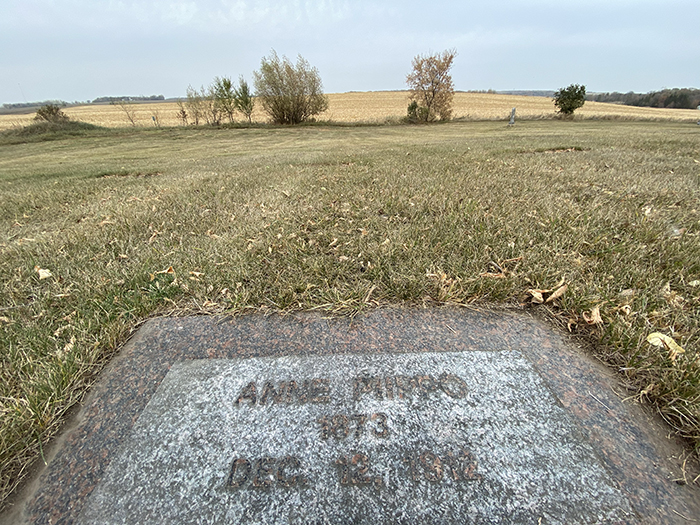A somber visit to the State Hospital
Published on November 29, 2022 at 3:38pm GMT+0000 | Author: Chad Koenen
0
Here, Annie Piippo’s gravestone sits on the slope of a hill overlooking a corn field near Fergus Falls. She, among thousands of others, is buried in the State Hospital Cemetery.
Tucker’s Telegram
Tucker Henderson
Recently, I had the privilege of attending a tour of the Fergus Falls State Hospital Cemetery given by Chris Schulke from the Otter Tail County Historical Society.
I have been meaning to attend one of these occasional tours for about five years, but never seemed to line up right. In October, it fell on a free Saturday and I made my hour-long trip to Fergus Falls that morning.
The crowd that lined up as I waited grew more and more. I didn’t realize there was such a strong interest in the tour, but I even recognized folks from Ottertail and Perham in the crowd with me! Hmm…where were you history fans from Mills?
We started the mile or so walk to the cemetery on what we were told was a “much better road than last year.” It seemed like a nice enough walk–level road, nice weather, and only a few cocklebur bushes to avoid–and we had a few history comments from Chris along the way.
When we finally got to the cemetery, it had a large stone marking where the different plots were and what years the rows were used in. We made our way to the oldest burial in the cemetery, a man buried in November of 1890. I stood near his grave and eventually looked down at what was the second burial in that cemetery—Fred Jussila, a Finn, also in November of 1890. Chris was standing not too far away, near another Finn’s grave—John Jacob Arola, buried in 1892.
As I walked among the newly placed stones from a now-defunct project called Dignity At Last, as well as a few older stones placed there by family members, I looked around for the 1912 row where one of my Piippo relatives is buried.
The group started moving towards the Poor Farm Cemetery, which is adjacent to the State Hospital Cemetery, but a short walk along another trail to get there. This was the last part of the tour, so I searched and searched for the Piippo name on any of the stones…but it was to no avail.
I hurried along so as not to miss the rest of the tour and arrived just in time to learn about the Poor Farm Cemetery, which was a field not too many years ago. It was where the poorest of the county were buried after they died at the county Poor Farm if no family claimed them. The Poor Farm was created in the early days before social security was enacted and took care of the poorest of our ancestors and neighbors when they couldn’t make a living alone anymore. Most of the folks that lived in the Poor Farm were either elderly or disabled in some way.
There are stones being placed in that cemetery as well, with stringent research being done to try and verify those buried there. If records for the State Hospital Cemetery are hard to find, the Poor Farm Cemetery records are largely nonexistent. Quite an undertaking for the few volunteers involved. As I walked around the small cemetery, I found a good few Finnish names in there as well. They almost certainly came from around this area.
I decided to return to find Annie Piippo’s grave after the tour was finished. I returned to the row of 1912 stones and started my search again. I remembered that Annie died December 12, 1912 (12/12/12) which made it much easier to find. I finally found her placed on the rise of the hill overlooking a corn field. Her son is buried there as well, but there is no stone, so I wasn’t able to find Ralph.
Annie’s story is a sad and unclear one. She immigrated from Finland in the late 1800s and in 1894, married John Piippo, who grew up in Otto Township. Annie had over 10 children and was placed in the State Hospital in her 30s. Our family speculates that she had postpartum depression and was, like many others, dropped at the feet of the state for care. John was listed as widowed in the next census, despite Annie being alive and living in the hospital. She died in 1912 and likely had no family around to comfort her. She was unclaimed and buried in the hospital cemetery.
Unfortunately, many of the stories of the buried folks at the State Hospital are much akin to Annie’s story. In times when mental health and other afflictions were unknown and society had little consideration for, many people were admitted to the hospital that didn’t need to be. They were often left to die there by their families and their conditions likely worsened for their abandonment.
It is important to see the hospital and cemetery and learn what kind of impact it had on our county. It is a sad and somber sight to be sure. It does give comfort in knowing that the treatment and knowledge of such common diagnoses relating to mental health has come a long way in the 130 plus years since the State Hospital opened and promised to treat their patients with “a steady diet of rest and warm milk.”
Annie’s story is one of thousands just in Fergus Falls, but I am glad to know that she, among others, is being remembered.

